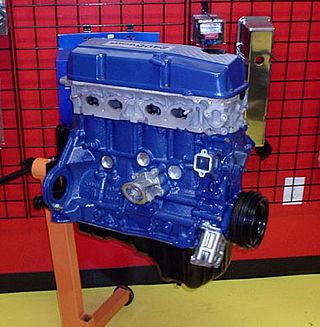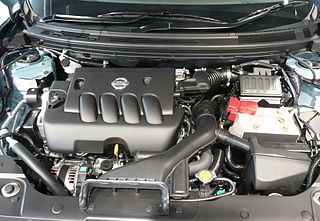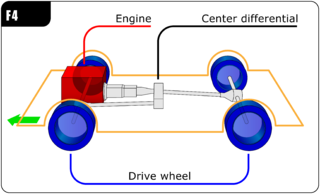
An axle or axletree is a central shaft for a rotating wheel or gear. On wheeled vehicles, the axle may be fixed to the wheels, rotating with them, or fixed to the vehicle, with the wheels rotating around the axle. In the former case, bearings or bushings are provided at the mounting points where the axle is supported. In the latter case, a bearing or bushing sits inside a central hole in the wheel to allow the wheel or gear to rotate around the axle. Sometimes, especially on bicycles, the latter type of axle is referred to as a spindle.

Four-wheel drive, also called 4×4 or 4WD, refers to a two-axled vehicle drivetrain capable of providing torque to all of its wheels simultaneously. It may be full-time or on-demand, and is typically linked via a transfer case providing an additional output drive shaft and, in many instances, additional gear ranges.

The RB engine is an oversquare 2.0–3.0 L straight-6 four-stroke gasoline engine from Nissan, originally produced from 1985 to 2004. The RB followed the 1983 VG-series V6 engines to offer a full, modern range in both straight or V layouts.

The KA engines were a series of four-stroke inline-four gasoline piston engines manufactured by Nissan, which were offered in 2.0 and 2.4 L. The engines blocks were made of cast-iron, while the cylinder heads were made of aluminum.

The Nissan Patrol is a series of full-size SUVs manufactured by Nissan in Japan and sold throughout the world.

The CA engine is a series of 1.6 to 2.0 L Inline-4 piston engines from Nissan. It is designed for a wide variety of smaller Nissan vehicles to replace the Z engine and some smaller, four-cylinder L series engines. The "CA" stands for Clean Air, due to the installation of Nissan emission reducing technology, called NAPS-X.
The Ford Motor Company produced straight-six engines from 1906 until 1908 and from 1941 until 2016. In 1906, the first Ford straight-six was introduced in the Model K. The next was introduced in the 1941 Ford. Ford continued producing straight-six engines for use in its North American vehicles until 1996, when they were discontinued in favor of more compact V6 designs.

The Jeep Comanche is a pickup truck variant of the Cherokee compact SUV (1984–1992) manufactured and marketed by Jeep for model years 1986-1992 in rear wheel (RWD) and four-wheel drive (4WD) models as well as two cargo bed lengths: six-foot and seven-foot.

The Nissan L series of automobile engines was produced from 1966 through 1986 in both inline-four and inline-six configurations ranging from 1.3 L to 2.8 L. It is a two-valves per cylinder SOHC non-crossflow engine, with an iron block and an aluminium head. It was the engine of the Datsun 510, Datsun 240Z sports car, and the Nissan Maxima. These engines are known for their reliability, durability, and parts interchangeability.

The Nissan Z engine is a series of automobile and light truck four-cylinder engines that was engineered by Nissan Machinery, manufactured by the Nissan Motor Company from 1979 through August 1989. All Z engines had 4 cylinders, a total of 8 valves and a single overhead camshaft (SOHC). Displacements ranged from 1.6 L to 2.4 L.The Z series' engine blocks were nearly identical to those of the earlier L Series with the exception of the Z24. While the Z16 and Z18 engines had a deck height similar to the earlier L13/L14/L16/L18 variants, the Z24 had a taller deck height to accommodate a longer stroke. The most notable difference between the Z-series engine and its predecessor was the introduction of a new crossflow cylinder head which reduced emissions by moving the intake ports to the right side of the engine opposite the exhaust ports. This change allows the exhaust port velocity to more effectively scavenge the cylinder and reduce reversion pulses to enhance induction. This change also limits maximum valve lift/lobe lift profiles rendering the cylinder head and valve train configuration undesirable for high-performance uses. The Z series evolved into the NA and KA engines which, along with the smaller CA series, replaced the Z series.

The Chrysler Hemi engines, known by the trademark Hemi or HEMI, are a series of American V8 gasoline engines built by Chrysler with overhead valve hemispherical combustion chambers. Three different types of Hemi engines have been built by Chrysler for automobiles: the first from 1951 to 1958, the second from 1964 to 1971, and the third beginning in 2003. Although Chrysler is most identified with the use of "Hemi" as a marketing term, many other auto manufacturers have incorporated similar designs. The engine block and cylinder heads were cast and manufactured at Indianapolis Foundry.

The Renault-Nissan MR engine family consists of straight-four 16-valve all-aluminium automobile engines with variable valve timing co-developed by Renault and Nissan. Renault calls it the M engine. Other noteworthy features of this engine family include acoustically equal runner lengths and a tumble control valve for the intake manifold, a "silent" timing chain, mirror finished crankshaft and camshaft journals, and offset cylinder placement in an attempt for increased efficiency.
The SD engine was replaced by the Nissan TD engine. It was manufactured by Minsei Diesel Industries, Ltd., which was renamed Nissan Diesel Motor Co., Ltd in 1960.

The UAZ-469 is an off-road military light utility vehicle manufactured by UAZ. It was used by Soviet and other Warsaw Pact armed forces, as well as paramilitary units in Eastern Bloc countries. In the Soviet Union, it also saw widespread service in state organizations that needed a robust and durable off-road vehicle. Standard military versions included seating for seven personnel.
Renix was a joint venture by Renault and Bendix that designed and manufactured automobile electronic ignitions, fuel injection systems, electronic automatic transmission controls, and various engine sensors. Major applications included various Renault and Volvo vehicles. The name became synonymous in the U.S. with the computer and fuel injection system used on the AMC/Jeep 2.5 L I4 and 4.0 L I6 engines.

In automotive design, an F4, or front-engine, four-wheel drive (4WD) layout places the internal combustion engine at the front of the vehicle and drives all four roadwheels. This layout is typically chosen for better control on many surfaces, and is an important part of rally racing, as well as off-road driving. In terms of racing purposes, whether it be on-road or off-road, can be described as follows,
A team that pursues the Weak LS4WD architecture will minimize the development cost of the front-wheel drive system at the expense of having a larger rear powertrain. The Weak architecture produces a vehicle with a large powersplit between the front and rear powertrains, while the Strong architecture recommends a vehicle with more similar power and torque requirements for the front and rear.
The 10.5" Corporate 14 Bolt Differential is a heavy duty differential found on many 1973-2013 Chevrolet and GMC trucks and SUVs, as well as certain versions of the Cadillac Escalade. Additionally, this differential is found on Chevrolet Express and GMC Savana vans produced from 1973 to current day. Debuting in 1973, this differential is a full floating design with a ring gear diameter of 10.5 inches (270 mm). As the name implies, this differential has 14 bolts holding on the differential cover. The ring gear is not held on with 14 bolts, but rather 12. The 14 bolt differential is a popular axle swap option for Jeep Wrangler owners, and is referred to as the "corporate" 14 bolt because of the odd nature of GM's corporate structure in the 1970s.

The Willys MC, formally the 1⁄4-Ton, 4 x 4, Utility Truck M38, or the G‑740 by its U.S. Army Standard Nomenclature supply catalog designation, is a quarter-ton four-wheel drive military light utility vehicle made by Willys between 1949 and 1952. It replaced, and succeeded the World War II Willys MB and Ford GPW models, with a total production of some 50,000 units — less than one tenth the number of WWII models built. Unlike during WWII, Ford was no longer involved in the production.
Vehicle Factory Jabalpur, is a military motor vehicle factory, located in Jabalpur, Madhya Pradesh, India, part of Armoured Vehicles Nigam Limited which was previously a part of Ordnance Factory Board, controlled by the Ministry of Defence, Government of India.
Vehículos Industriales y Agrícolas, S.A. was a Spanish automobile company, a division of parent company Construcciones y Auxiliares de Ferrocariles (CAF).















